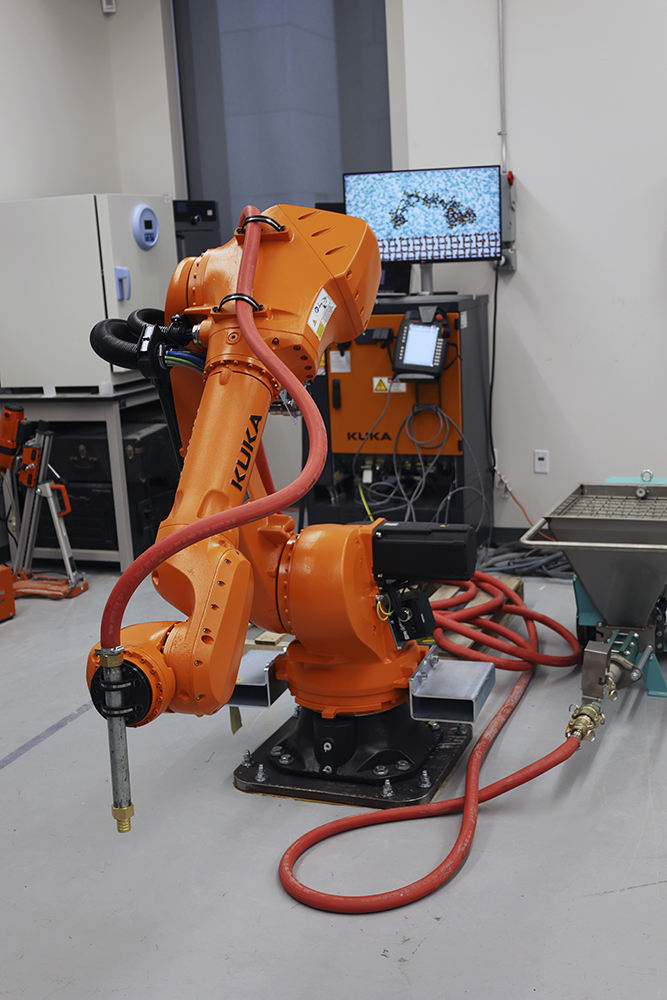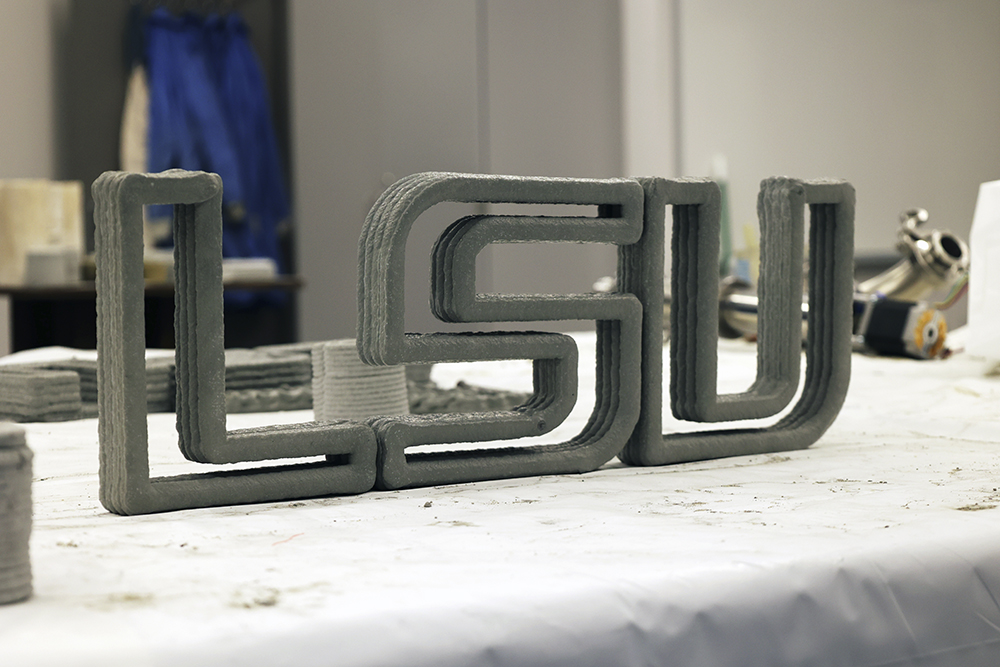LSU Engineering Researchers Seek Advancements in Underwater Construction
 November 15, 2023
November 15, 2023
BATON ROUGE, LA – In 2022, the average global sea level reached a record high at 101.2 millimeters—four inches above 1993 levels. That same year, the National Weather Service recorded an all-time high of 13 “significant weather events.” Both of these statistics signal a greater challenge when it comes to the resiliency of coastal communities and their infrastructure, but it’s one a pair of LSU Engineering researchers are taking on through a nearly $500,000 National Science Foundation Future Manufacturing Award.
LSU Civil and Environmental Engineering Assistant Professor Yen-Fang Su and LSU Chemical Engineering Assistant Professor Yaxin An are exploring the potential of additive manufacturing as an autonomous, advanced construction method to overcome the challenges of underwater construction—such as severe working conditions, restricted access, and potential ecological damage. Specifically, the pair will utilize artificial intelligence-driven material modeling to help them select and determine the best bio-based construction materials for use in underwater construction through a novel-sensing approach.
“To successfully implement underwater additive manufacturing, three key aspects must be considered—materials, manufacturing procedures, and instrumentation,” Su said. “Building upon our current work on additive manufacturing and sensing, Dr. An’s team is using molecular dynamics simulations to calculate the important thermodynamic properties in admixture/cement systems that can provide insight for us to select/design the admixtures that have better compatibility between admixture and cement.
“Our team will quantify various properties of the materials using the AI-assisted sensing method developed in our lab, which is supported by an LSU Provost’s Emerging Research Grant, based on the metrics we provided for Dr. An’s group to validate and calibrate the material models. We will further develop a physics-guided, machine-learning model that takes environmental conditions, material composition, and additive-manufacturing process factors into consideration.”
Traditionally, building underwater structural components is complicated and requires pumping or placing concrete using a tremie pipe, a long tube that extends to the seabed and ensures accurate placement while minimizing disturbance to the surrounding water. Repairing those structures once they’re built requires highly-skilled divers equipped with specialized gear and techniques to carry out the process. Neither approach is ideal for various reasons.
“These traditional methods pose numerous challenges in the hazardous conditions which impact both workers and the environment, including harsh working conditions such as low visibility, strong currents, and high pressure,” Su said. “Equipment and technology limitations in underwater environments also present challenges. Although advances in remotely operated vehicles and autonomous underwater vehicles have enabled the inspection and surveying of underwater environments, they have yet to fully address the challenges of underwater construction. Balancing environmental concerns is also crucial for sustainable development in underwater construction. Preserving marine ecosystems and reducing pollution by using biocompatible materials is essential for protecting the environment and ensuring long-term sustainability.”
 If their project is successful, both Su and An believe it will not only address those
aforementioned challenges, but it will also have far-reaching benefits for the construction
industry and coastal communities.
If their project is successful, both Su and An believe it will not only address those
aforementioned challenges, but it will also have far-reaching benefits for the construction
industry and coastal communities.
“It will improve our fundamental understanding of the interaction between organic (admixtures) and inorganic materials (cements), providing guidance into the optimization of materials formulation for underwater construction,” An said. “This is the first key step to successfully implementing underwater 3D printing.”
“This will mean we will have sufficient preparation—models, knowledge, technology, workforce—to face future unpredictable challenges in the engineering of future habitats and infrastructure under extreme environments,” Su added. “It will also provide the insight to tackle the extraterrestrial inhospitable environments in the future. The energy sector, defense sector, and underwater robotics will experience innovation from the insights derived from this project.”
Like us on Facebook (@lsuengineering) or follow us on Twitter and Instagram (@lsuengineering).
###
Contact: Joshua Duplechain
Director of Communications
225-578-5706
josh@lsu.edu
Latest College of Engineering News
- Computer Science PhD Student First to Receive Competitive AwardApril 25, 2024BATON ROUGE, LA - LSU Computer Science Ph.D. student Ruxin Wang is the recipient of the highly competitive 2024 Cyber-Physical Systems (CPS) Rising Stars Award, making her the first-ever LSU student to receive the honor. She is also the first female LSU student to publish a first-author security paper at one of the Big 4 Security conferences.
- LSU Mechanical Engineering Professor Designs Toxic Chemical SensorApril 24, 2024BATON ROUGE, LA - LSU Mechanical Engineering Associate Professor Manas Gartia is leading a team of researchers in designing a novel electrochemical sensor that will detect toxic chemicals in the environment. This sensor will help with environmental research, public health testing, and PFAS containment and alarm system.
- Wang Receives NSF CAREER Award, Research Addresses Privacy Concerns in VideoconferencingApril 18, 2024BATON ROUGE, LA - Since the pandemic, our primary means of interacting have evolved to include video conferencing applications, which are broadly used to connect geographically distant people for work, school, and even socially. During these interactions, it's not uncommon for a user to turn off his or her microphone and/or camera out of concern for privacy. However, microphones and cameras can still leak other kinds of information beyond what is seen and heard through "micro signals," which are too tiny for humans to recognize but detectable by machines.
- LSU Civil, Environmental Engineering Researchers Study Coastal Wetland Root DynamicsApril 16, 2024BATON ROUGE, LA - A team of LSU researchers led by LSU Civil and Environmental Engineering Associate Professor Navid Jafari (principal investigator) and LSU CEE Research Assistant Mohamed Hassan (co-PI) recently received a $50,000 National Science Foundation I-Corps grant to commercialize its algorithms in studying root productivity in Louisiana wetlands. A second grant was awarded by the Environmental Molecular Sciences Laboratory (EMSL), which is part of the Pacific Northwest National Laboratory in Richland, Wash., that allows the team to use X-ray computed tomography (XCT) and optical coherence tomography (OCT) scans to study these roots.
- LSU, Delaware and Johns Hopkins Researchers Examine the Mechanics of the Human BrainApril 4, 2024BATON ROUGE, LA - Faculty from LSU, the University of Delaware, and Johns Hopkins University are collaborating on a project that may help us better understand how fast or slow mechanical forces deform the brain during events such as falls and car crashes. Having this understanding is critical to developing computer models for predicting brain injury, as well as designing safer personal protective equipment and brain injury management and prevention strategies.
- LSU Mechanical Engineering Professor Researches Biodegradable, Metal-Free BatteriesApril 1, 2024BATON ROUGE, LA - Each year, Americans throw away more than 3 billion batteries, creating 180,000 tons of hazardous waste. Imagine how many more are discarded throughout the world. Thanks to a $50,000 grant, LSU Mechanical Engineering Associate Professor Ying Wang is exploring biodegradable, metal-free batteries that will be more sustainable in the medical field and less harmful on the environment.


